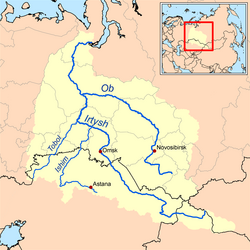Ishim River
| Ishim River | |
|---|---|

The river Ishim in Astana, a popular thoroughfare in the winter when it is frozen over.
|
|

Map of the Ob–Irtysh drainage basin showing the Ishim River
|
|
| Country | Kazakhstan, Russia |
| Physical characteristics | |
| Length | 2,450 km (1,520 mi) |
| Discharge |
|
Ishim River (Russian: Иши́м/Išim; Kazakh: Есіл/Esil, هسىل) is a river running through Kazakhstan and Russia. It is 2,450 kilometres (1,520 mi) long; its average discharge is 56.3 cubic metres per second (1,990 cu ft/s). It is a left tributary of the Irtysh River. The Ishim River is partly navigable in its lower reaches. The upper course of the Ishim passes through Astana, the capital of Kazakhstan. In Russia, the river travels through a vast marshland for its course, and has countless meanders and oxbow lakes. The river freezes from late November until March.
According to the President of Kazakhstan, Nursultan Nazarbayev, Astana was chosen as the capital in part due to the presence of the river. The city is also divided into two sections, the Right (northern) Bank of the Ishim or the old town, and the Left (southern) Bank, where the new government buildings such as the Ak Orda, the House of the Government, and the Supreme Court are located, as well as many prestigious apartment and living complexes.
Since 1998, the Ishim River in Astana has been actively managed, for flood management and maintaining water level, in order to provide for recreational use and ensure the showpiece appearance. It is dammed downstream of central Astana, keeping its level higher than it otherwise would be most of the time, while the river bottom has been made deeper, in order to let flood waters through faster. In central Astana, near the city park, there is now a public beach and pedalo boat rental; meanwhile, if the river had not been dammed, "citizens would have been able to walk across it". Another dam will be constructed upstream of the city, for better flood control.
The city authorities also have plans for further deepening the river, which will eventually allow small passenger boats to operate on a 22-kilometre (14 mi) section of the river through the nation's capital.
To maintain the desired level of water flow, water is pumped to the Ishim from the Irtysh River, over the Irtysh–Karaganda Canal and a pipeline.
...
Wikipedia
